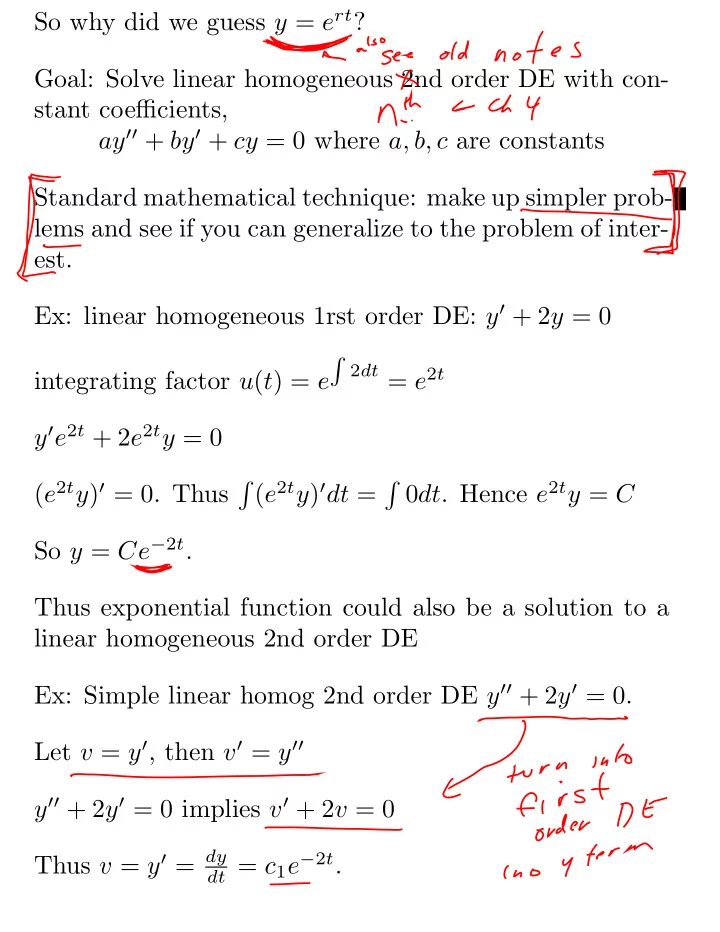

So why did we guess y = e rt ? Goal: Solve linear homogeneous 2nd order DE with con- stant coefficients, ay ′′ + by ′ + cy = 0 where a, b, c are constants Standard mathematical technique: make up simpler prob- lems and see if you can generalize to the problem of inter- est. Ex: linear homogeneous 1rst order DE: y ′ + 2 y = 0 ∫ 2 dt = e 2 t integrating factor u ( t ) = e y ′ e 2 t + 2 e 2 t y = 0 ( e 2 t y ) ′ = 0. Thus ( e 2 t y ) ′ dt = 0 dt . Hence e 2 t y = C ∫ ∫ So y = Ce − 2 t . Thus exponential function could also be a solution to a linear homogeneous 2nd order DE Ex: Simple linear homog 2nd order DE y ′′ + 2 y ′ = 0. Let v = y ′ , then v ′ = y ′′ y ′′ + 2 y ′ = 0 implies v ′ + 2 v = 0 Thus v = y ′ = dy dt = c 1 e − 2 t .
y ′ ( t ) = dy dt = c 1 e − 2 t . To find c 1 , we need to know initial value y ′ ( t 0 ) = y 1 dy = c 1 e − 2 t dt Separate variables: y = c 1 e − 2 t + c 2 . Note 2 integrations give us 2 constants, c 1 and c 2 To find constants, we need initial values, y ( t 0 ) = y 0 and y ′ ( t 0 ) = y 1 Note also that the general solution is a linear combination of two solutions: Let c 1 = 1 , c 2 = 0, then we see, y ( t ) = e − 2 t is a solution. Let c 1 = 0 , c 2 = 1, then we see, y ( t ) = 1 is a solution. The general solution is a linear combination of two sol- utions: y = c 1 e − 2 t + c 2 (1). Recall: you have seen this before: Solve linear homogeneous matrix equation A y = 0 . The general solution is a linear combination of linearly independent vectors that span the solution space: y = c 1 v 1 + ...c n v n
FYI: You could see this again: Math 4050: Solve homogeneous linear recurrance relation x n − x n − 1 − x n − 2 = 0 where x 1 = 1 and x 2 = 1. Fibonacci sequence: x n = x n − 1 + x n − 2 1, 1, 2, 3, 5, 8, 13, 21, ... √ √ 1 5 ( 1+ 5 1 5 ( 1 − 5 ) n − ) n Note x n = √ √ 2 2 Proof: x n = x n − 1 + x n − 2 implies x n − x n − 1 − x n − 2 = 0 Suppose x n = r n . Then x n − 1 = r n − 1 and x n − 2 = r n − 2 Then 0 = x n − x n − 1 − x n − 2 = r n − r n − 1 − r n − 2 Thus r n − 2 ( r 2 − r − 1) = 0. 1 ± √ √ 1 − 4(1)( − 1) = 1 ± 5 Thus either r = 0 or r = 2 2 √ √ ) n ) n ( ( 1+ 5 1 − 5 Thus x n = 0, x n = and f n = 2 2 are 3 different sequences that satisfy the homog linear recurrence relation: x n − x n − 1 − x n − 2 = 0. √ √ ) n ) n ( ( 1+ 5 1 − 5 Hence x n = c 1 + c 2 also satisfies this 2 2 homogeneous linear recurrence relation. Suppose the initial conditions are x 1 = 1 and x 2 = 1
Then for n = 1: x 1 = 1 implies c 1 + c 2 = 1 √ √ ( ) ( ) 1+ 5 1 − 5 For n = 2: x 2 = 1 implies c 1 + c 2 = 1 2 2 We can solve this for c 1 and c 2 to determine that √ √ 1 5 ( 1+ 5 1 5 ( 1 − 5 ) n − ) n x n = √ √ 2 2
Recommend
More recommend